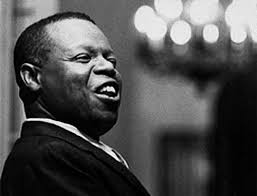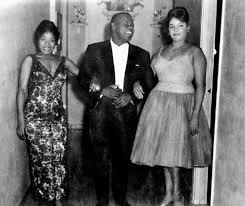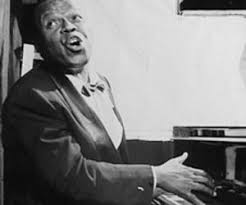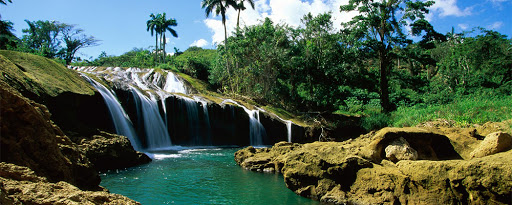“BOLA DE NIEVE” (SNOWBALL), CUBAN SINGER AND COMPOSER DEFINED AS A “GARCÍA LORCA NEGRO”. PHOTOS/VIDEOS.
“Bola de Nieve” born Ignacio Jacinto Villa Fernández, was a Cuban singer-songwriter and singer-songwriter. His name originates from his round black face. He was born in Guanabacoa, Havana on September 11, 1911, and was a prolific performer of Boleros, Habaneras, and Son Cubano.
The Spanish poet Rafael Alberti once defined him as a “García Lorca Negro”. Another great of world poetry, Chilean Pablo Neruda defined it as follows: “Bola de Nieve married music and lives with it in that intimacy full of pianos and bells, throwing the keyboards of heaven over his head. Long live her earthly joy! Hail to his sonorous heart! “This could only have been written by Neruda.
Bola de Nieve is undoubtedly one of the greatest musicians that the Caribbean island has produced and a genuine icon of Cuban idiosyncrasy.
https://youtu.be/QD6ZC7Fo9Hs
Press ^ Here
BOLA DE NIEVE SINGS “NO TE PUEDO OLVIDAR”
Villa Fernández studied music theory and music theory at the Mateu Conservatory of Havana, at that time Ignacio Villa was called by his schoolmates Bola de Nieve (quite the opposite of how tight he was), a nickname that then disgusted. When he was older he enrolled in the Normal School for Teachers. He worked as a chauffeur and played the piano for silent films until his friend Rita Montaner hired him as an escort in the early 1930s on a trip to Mexico.
Villa Fernández remained in Mexico and developed an original playing style as a pianist and singer. He was an elite figure more than popular, a sophisticated cabaret stylist known for his tongue-in-cheek tapping, subtle musical performance of him, with a repertoire that included songs in French, English, Catalan, Portuguese, and Italian.
After successful tours, Ignacio Villa returned to Cuba in 1935, under the exclusive contract of Ernesto Lecuona. With the Master, he performed on prestigious stages throughout America and Spain, and the United States. In this last place, the newspaper The New York Times described it as a true revelation for his artistic personality. Radio, theater, and cabaret were his favorite places.
https://youtu.be/qUWiN688-70
Press ^ Here
BOLA DE NIEVE SINGS “MI TAMBOR”
They compared him to Maurice Chevaliér and Nat King Cole. At the famous Carnegie Hall, he received one of the great emotions of his life by receiving an endless ovation. In the 1950s he conquered France, Denmark, Nice, Rome, Venice, and Milan. He returned to Mexico, his second homeland, and there he shared with figures such as Pedro Vargas, Toña la Negra, and Agustín Lara. Around that time he met Edith Piaf, who said: “Nobody sings ‘La vida en rosa’ like Snowball.
Bola recorded for the Orfeón, Discmedi, RCA Victor Mexicana, Montilla, Sonotone, Kubaney, Modiner and Areito record companies.
El Bola had defined and perfected his style of saying the song. For him there was no improvisation: he studied and matured each theme. He dominated the cartoonish song, that of unalterable elaboration and that of folkloric inflections of any country. As expressive resources, he used melody, rhythm, and the message of the texts alike.
Bola de Nieve recreated songs in English (Be careful, it’s my heart), in French (La vie en rose), Italian, Catalan, and Portuguese; he dared with old Spanish romances like El caballero de Olmedo and also contributed his own compositions: If you could love me, Don’t let me forget you or that ¡Ay, amor! and a separate mention of her unique version of “La Flor de la Canela” by Chabuca Granda, which the author praised.
He made numerous tours of Europe and America, and his friends included Andrés Segovia and Pablo Neruda. He identified as black and gay, had self-confidence in his personality, and accepted for who he was: a memorable talent.
In 1965 he renovated the restaurant “Monseñor” located in front of the Hotel Nacional de Cuba. The site became “Chez Bola”, an intimate place where the artist, in addition to singing and playing the piano, talked, told stories, jokes, anecdotes, and greeted from table to table. Bola lived in the National Hotel then.
He died in Mexico City during a musical visit on his way to Peru for performances on October 2, 1971 (age 60).
He was the subject of a documentary in 2003 that included interviews with fellow musicians, friends, family, and experts.
DISCOGRAPHY
1933: Don’t let me forget you (Mexico).
1940: You have to love me (RCA Victor).
1941: Miss Chi Chi y Pampa (RCA Victor, from Argentina).
1947: Goat that breaks tambó, Drume, negrita, El dulcero, Mesié Julián (Coda, from Cuba).
1955: I can’t be happy, What would you say about me, You don’t love me anymore, The dove was wrong, Don’t tell me, If you could love me, Drume, Negrita, Mesié Julián, (LP, RCA Víctor; Mexico).
1956: Yambambó, Ay, amor y otros ten songs (RCA Victor, from Mexico).
1957: Snowball with his piano (Montilla, from Spain).
1960: This is Bola (Sonotone, from Cuba).
FILMOGRAPHY
Melodies of America (1941)
BOLA DE NIEVE, CANTANTE Y COMPOSITOR CUBANO DEFINIDO COMO UN “GARCÍA LORCA NEGRO”
“Bola de Nieve” nacido como Ignacio Jacinto Villa Fernández, fue un cantautor y cantautor cubano. Su nombre se origina en su rostro negro y redondo. Nacio en Guanabacoa, La Habana el 11 de Septiembre de 1911 y fue un prolifico ejecutor de Boleros, Habaneras y el Son Cubano.
El poeta espanol Rafael Alberti lo definio una vez como un “García Lorca Negro”. Otro grande de la poesia mundial, el chileno Pablo Neruda lo definió así: “Bola de Nieve se casó con la música y vive con ella en esa intimidad llena de pianos y cascabeles, tirándose por la cabeza los teclados del cielo. ¡Viva su alegría terrestre!¡Salud a su corazón sonoro!”, esto solo podía haberlo escrito Neruda.
Bola de Nieve sin duda de uno de los más geniales músicos que ha dado la isla caribeña y un genuino icono de la idiosincrasia cubana.
https://youtu.be/dFQIacUgleo
Presione ^ Aqui
BOLA DE NIEVE CANTA “EL MANICERO”
Villa Fernández estudió en el Conservatorio Mateu de La Habana, estudios de solfeo y teoría de la música, hacia entonces Ignacio Villa fue llamado por sus compañeros de escuela Bola de Nieve (todo lo contrario a lo bien prieto que era), apodo que entonces le disgustaba. Ya mayor matriculó en la Escuela Normal para Maestros. Trabajó como chófer y tocó el piano para películas mudas hasta que su amiga Rita Montaner lo contrató como acompañante a principios de la década de 1930 en viaje a México.
Villa Fernández permaneció en México y desarrolló un estilo de interpretación original como pianista y cantante. Era una figura de élite más que popular, un sofisticado estilista de cabaret conocido por su golpeteo irónico, su interpretación musical sutil, con un repertorio que incluía canciones en francés, inglés, catalán, portugués e italiano.
https://youtu.be/QFoQNL6vvrc
Presione ^ Aqui
BOLA DE NIEVE CANTA “AY MAMA INES”
Después de exitosas giras, Ignacio Villa regresó a Cuba en 1935, bajo contrato exclusivo de Ernesto Lecuona. Con el Maestro se presentó en prestigiosos escenarios de toda América y España y Estados Unidos. En este último lugar el periódico The New York Times lo calificó como una verdadera revelación por su personalidad artística. La radio, el teatro y el cabaret eran sus plazas preferidas.
Le compararon con Maurice Chevaliér y Nat King Cole. En el famoso Carnegie Hall recibió una de las grandes emociones de su vida al recibir una ovación que no se acababa, interminable. En los años 50 conquistó Francia, Dinamarca, Niza, Roma, Venecia y Milán. Volvió a México, su segunda patria y allí compartió con figuras como Pedro Vargas, Toña la Negra y Agustín Lara. Por esa época conoció a Edith Piaf, quien dijo: “Nadie canta “La vida en rosa” como Bola de Nieve.
https://youtu.be/nBrNq8-rTVQ
Presione ^ Aqui
BOLA DE NIEVE CANTA “AY AMOR!”
Bola grabó para las Empresas Discograficas Orfeón, Discmedi, RCA Victor Mexicana, Montilla, Sonotone, Kubaney, Modiner y Areito.
El Bola había definido y perfeccionado su estilo de decir la canción. Para él no existía la improvisación: estudiaba y maduraba cada tema. Dominaba la canción caricaturesca, la de inalterable elaboración y la de inflexiones folclóricas de cualquier país. Como recursos expresivos utilizaba por igual la melodía, el ritmo y el mensaje de los textos.
Bola de Nieve recreaba canciones en inglés (Be careful, it´s my heart), en francés (La vie en rose) italiano, catalán y portugués; se atrevía con viejos romances españoles como El caballero de Olmedo y aportaba también sus propias composiciones: Si me pudieras querer, No dejes que te olvide o ese ¡Ay, amor!; y mención aparte de su inigualable versión de “la Flor de la Canela” de Chabuca Granda, la cual la autora alababa.
https://youtu.be/bDh9bDXJTJk
Presione ^ Aqui
BOLA DE NIEVE CANTA “LA FLOR DE LA CANELA”
Realizó numerosas giras por Europa y América, y entre sus amigos se encontraban Andrés Segovia y Pablo Neruda. Se identificó como negro y gay, tenía confianza en sí mismo en su personalidad y aceptó por lo que era: un talento memorable.
En 1965 se remozó el restaurante “Monseñor” situado enfrente del Hotel Nacional de Cuba. El sitio se convirtió en “Chez Bola”, íntimo lugar donde el artista además de cantar y tocar el piano, dialogaba, hacía cuentos, chistes anécdotas y saludaba de mesa en mesa. Bola, vivía en el Hotel Nacional entonces.
Murió en la Ciudad de México durante una visita musical en su paso para actuaciones en Perú el 2 de Octubre de 1971 (60 años).
Fue objeto de un documental en el 2003 que incluyó entrevistas con compañeros músicos, amigos, familiares y expertos.
DISCOGRAFIA
1933: No dejes que te olvide (México).
1940: Tú me has de querer (RCA Victor).
1941: Señorita Chi Chi y Pampa (RCA Victor, de Argentina).
1947: Chivo que rompe tambó, Drume, negrita, El dulcero, Mesié Julián (Coda, de Cuba).
1955: No puedo ser feliz, Qué dirías de mí, Ya no me quieres, Se equivocó la paloma, No me platiques, Si me pudieras querer, Drume, negrita, Mesié Julián, (LP, RCA Víctor; México).
1956: Yambambó, Ay, amor y otros diez temas (RCA Victor, de México).
1957: Bola de Nieve con su piano (Montilla, de España).
1960: Este sí es Bola (Sonotone, de Cuba).
FILMOGRAFIA
Melodías de América (1941)
Agencies/ Wiki/ Memorias Cubanas/ Carlos RodriguezB./ Extractos/ Excerpts/ Internet Photos/ YouTube/ Arnoldo Varona/ www.TheCubanHistory.com
THE CUBAN HISTORY, HOLLYWOOD.











